A Review of the Impact of Graphene Oxide on Cement Composites
Abstract
:1. Introduction
2. Dispersion
- (1)
- Optimizing the amount of PCE to avoid GO aggregation within the cementitious system. Research indicates that when the PCE:GO mass ratio is <1, the distribution of GO in cement pore solutions is significantly limited. However, increasing the PCE:GO mass ratio to 3–5 improves the stability of GO dispersion in the cement matrix [58]. Studies by Long [20] and Marbaniang [24] found that when the PCE/GO mass ratio is 10–20%, PCE coordinates with Ca2+ through its molecular chains, effectively inhibiting the bridging effect of Ca2+ on the GO surface and significantly enhancing dispersion. However, excessively high PCE concentrations can limit further interaction between GO and cement particles due to micelle formation, reducing dispersion efficiency. As a result, the amount of PCE should be considered an essential factor when preparing GO-containing cement composites.
- (2)
- Optimizing the order of mixing cement, water, GO, and PCE. Research has shown that changing the mixing sequence can achieve two different states of GO dispersion: when GO and PCE are first mixed to form a suspension before being combined with cement, GO can disperse uniformly. Conversely, if GO is directly mixed with cement first (i.e., GO suspension is mixed with cement) and then PCE is added, GO aggregation occurs [60]. Similar phenomena have been observed by other researchers, where direct mixing of GO with cement results in a strong electrostatic shielding effect due to the chemical interaction between calcium ions and GO, limiting the adsorption and distribution effects of PCE molecular chains and causing irreversible GO aggregation [61]. Therefore, GO should be protected with PCE prior to its introduction into the cementitious mixture to prevent reactions with Ca2+.
- (3)
- The dispersion efficiency of GO is closely associated with the molecular structure of PCE, particularly its side chains, backbone, charge density, polymer molecular weight, and functional moieties [23,26,62]. The dispersion of GO within cement pore solutions is also influenced by its flake size, oxygen content, and concentration [43,63]. As a result, carefully selecting the appropriate surfactant is crucial for achieving effective distribution of GO within the cementitious system.
- (4)
- Verification experiments are suggested to confirm the dispersibility of GO within cement pore solutions. Although scanning electron microscopy (SEM) can provide detailed images of the microstructure of hardened cement composites after adding GO, studies have shown that SEM cannot fully capture the large-scale distribution of GO in the sample, especially in potential aggregation areas [64,65]. Moreover, due to the low dosage of GO (<0.1%), its small size, poor contrast with cement hydration products, and the limited resolution of SEM, it becomes challenging to distinguish GO nanosheets at the macroscopic scale in cement matrices [49,50]. Guo and colleagues [23] employed backscattered electron imaging (BSE) techniques to observe and assess the distribution of nanomaterials in cement pore solutions.
- (5)
- The side effects of high dosages of superplasticizers should be noted. In low water-to-cement ratios or high nanomaterial content, additional superplasticizers are needed to achieve better dispersion. However, when PCE exceeds the saturation dosage, the slurry becomes overly fluid, increasing the risk of segregation and bleeding [66,67]. Studies have shown that excessive long side chains of PCE can cause increased slurry viscosity and reduced fluidity [68]. Therefore, developing advanced superplasticizers to more effectively distribute GO in cement pore solutions is imperative.
3. Performance
3.1. Workability
3.2. Mechanical Properties
3.3. Durability
4. Mechanism
4.1. Hydration Kinetics
4.2. C-S-H Structure
4.3. Pore Structure
4.4. Interface Bonding
5. Hybrid Approaches
6. Conclusions and Prospects
Author Contributions
Funding
Data Availability Statement
Conflicts of Interest
References
- Yang, K.; Long, G.; Tang, Z.; Wu, H.; Ma, G.; Cheng, Z.; Xiang, Y.; Xie, Y. Enhancement in Strength and Toughness of Ultra-High Performance Concrete (UHPC) from Micron- and Nano-Scale. J. Build. Eng. 2023, 69, 106308. [Google Scholar] [CrossRef]
- Wang, R.; Sun, R.; Zhao, L.; Zhang, T.; Kong, X.; Fu, Y. Investigation of the Dispersion of Reduced Graphene Oxide in Ce-mentitious Composites under Different Mixing Strategies. J. Build. Eng. 2023, 77, 107447. [Google Scholar] [CrossRef]
- Adebanjo, A.U.; Abbas, Y.M.; Shafiq, N.; Khan, M.I.; Farhan, S.A.; Masmoudi, R. Optimizing Nano-TiO2 and ZnO Integration in Silica-Based High-Performance Concrete: Mechanical, Durability, and Photocatalysis Insights for Sustainable Self-Cleaning Systems. Constr. Build. Mater. 2024, 446, 138038. [Google Scholar] [CrossRef]
- Kim, G.; Cho, S.; Moon, J.; Suh, H.; Her, S.; Sim, S.; Bae, S. Investigation of the Hydrate Formation and Mechanical Performance of Limestone Calcined Clay Cement Paste Incorporating Nano-CaCO3 and Nano-SiO2 as Partial Limestone Substitutes. Constr. Build. Mater. 2024, 418, 135335. [Google Scholar] [CrossRef]
- Ye, Y.; Li, L.; Song, Y.; Yu, H.; Shi, T.; Ye, Q. Effects of Nano MgO and Light-Burnt MgO on Mechanical Properties and Long-Term Expansion of Paste Mixed with Portland Cement and Slag. Constr. Build. Mater. 2024, 443, 137756. [Google Scholar] [CrossRef]
- Li, L.G.; Lai, Q.; Zeng, G.-X.; Li, Y.-J.; Xie, H.-Z.; Kwok Hung Kwan, A. Combined Effects of Micro and Nano Fe3O4 on Workability, Strength, Packing, Microstructure and EM Wave Absorbing Properties of Mortar. Constr. Build. Mater. 2023, 406, 133407. [Google Scholar] [CrossRef]
- Yan, X.; Tang, W.; Cui, H. Effect of MWCNTs-OH on the Mechanical Properties of Cement Composites: From Macro to Micro Perspective. Constr. Build. Mater. 2024, 444, 137652. [Google Scholar] [CrossRef]
- Wang, Z.; Bai, E.; Liu, C.; Ren, B.; Zhang, J. Strength, Toughness and Interface Modification of Graphene Oxide Grafted Carbon Fiber Modified Concrete. Constr. Build. Mater. 2024, 428, 136336. [Google Scholar] [CrossRef]
- Wang, Z.; Bai, E.; Liang, L.; Du, Y.; Liu, C. Comparison of Dynamic Mechanical Properties of Carbon Fiber and Graphene Oxide Grafted Carbon Fiber Modified Concrete. J. Build. Eng. 2024, 94, 109989. [Google Scholar] [CrossRef]
- Novoselov, K.S.; Geim, A.K.; Morozov, S.V.; Jiang, D.; Zhang, Y.; Dubonos, S.V.; Grigorieva, I.V.; Firsov, A.A. Electric Field Effect in Atomically Thin Carbon Films. Science 2004, 306, 666–669. [Google Scholar] [CrossRef]
- He, H.; E, S.; Qiao, H.; Yang, J.; Lin, C.; He, C.; Xu, P. A General and Simple Method to Disperse 2D Nanomaterials for Promoting Cement Hydration. Constr. Build. Mater. 2024, 427, 136217. [Google Scholar] [CrossRef]
- Edwards, N.J.; Lin, Y.; Du, H.; Ruan, D. Effect of Graphene Oxide on Cement Mortar under Quasi-Static and Dynamic Loading. J. Build. Eng. 2023, 74, 106783. [Google Scholar] [CrossRef]
- Kaur, R.; Bhatrola, K.; Kumar, A.; Kaur, J.; Suhag, S.; Maurya, S.K.; Kothiyal, N.C. Durability of Cementitious Mortar: Incorporation of Highly Dispersed Superplasticizer Modified Graphene Oxide in Fly Ash Blended Mortar. J. Build. Eng. 2023, 80, 107888. [Google Scholar] [CrossRef]
- Zhou, Y.; Liu, C.; Gao, J.; Chen, X.; Luo, X.; Zhang, G.; Gu, T.; Zhang, L.; Liu, L. Effect of Graphene Oxide on Hydration and Performance of Phosphogypsum-Based Self-Leveling Materials Used for Floor Heating Backfill. Constr. Build. Mater. 2024, 449, 138367. [Google Scholar] [CrossRef]
- Belli, A.; Mobili, A.; Bellezze, T.; Cachim, P.B.; Tittarelli, F. Commercial and Recycled Carbon-Based Fillers and Fibers for Self-Sensing Cement-Based Composites: Comparison of Mechanical Strength, Durability, and Piezoresistive Behavior. J. Build. Eng. 2023, 73, 106836. [Google Scholar] [CrossRef]
- Li, P.; Yang, C.; Xu, F.; Li, J.; Jin, D. Reinforcement of Insufficient Transverse Connectivity in Prestressed Concrete Box Girder Bridges Using Concrete-Filled Steel Tube Trusses and Diaphragms: A Comparative Study. Buildings 2024, 14, 2466. [Google Scholar] [CrossRef]
- Chen, X.; Qu, Z.; Liu, Z.; Ren, G. Mechanism of Oxidization of Graphite to Graphene Oxide by the Hummers Method. ACS Omega 2022, 7, 23503–23510. [Google Scholar] [CrossRef]
- Fonseka, I.; Mohotti, D.; Wijesooriya, K.; Lee, C.-K.; Mendis, P. Influence of Graphene Oxide Properties, Superplasticiser Type, and Dispersion Technique on Mechanical Performance of Graphene Oxide-Added Concrete. Constr. Build. Mater. 2024, 428, 136415. [Google Scholar] [CrossRef]
- Liao, C.; Lin, B.; Li, M.; Dai, G.; Hu, S. Synergistic Effects of Graphene Oxide and Fly Ash on Rheology, Mechanical Properties, and Microstructure of Highly-Flowable Cementitious Grouts. J. Build. Eng. 2024, 87, 109038. [Google Scholar] [CrossRef]
- Long, W.-J.; Luo, S.; Zhang, X.-H.; Xu, P.; Luo, Q.-L.; Feng, G.-L. A Novel Approach for Chloride Control in Sea Sand Cement Composites Utilizing Graphene Oxide. Constr. Build. Mater. 2023, 389, 131779. [Google Scholar] [CrossRef]
- Suh, H.; Kim, G.; Cho, S.; Li, P.; Son, D.-H.; Koo, D.; Lim, J.; Choi, C.-S.; Seok, S.; Bae, S. Comparative Analysis of the Synergistic Effects of Hybrid Nanomaterial Reinforcement in Cementitious Composites: A Perspective for Pore Refinement and Thermal Resistance. Constr. Build. Mater. 2023, 401, 132856. [Google Scholar] [CrossRef]
- Zhang, R.; Long, Z.; Long, G.; Wang, J.; Wang, X.; Zhang, X.; Jiang, Y. Mechanism of Graphene Oxide Concrete Macro-Micro Properties Evolution under Large Temperature Difference Freeze-Thaw Action. Constr. Build. Mater. 2024, 415, 135019. [Google Scholar] [CrossRef]
- Guo, H.; Gao, R.; Liu, S.; Feng, C.; Qin, M.; Sun, G. Effect of Ultra-Low Dosage Graphene Oxide on the Properties of Recycled Cement-Based Materials. J. Build. Eng. 2024, 91, 109637. [Google Scholar] [CrossRef]
- Marbaniang, D.F.; Adak, D.; Kar, A.; Barbhuiya, S.; Chottemada, P.G.; Marthong, C. Enhancing Mechanical Strength and Microstructural Properties of Alkali-Activated Systems through Nano Graphene Oxide Dispersion and Polycarboxylate Ether Ad-mixture. Constr. Build. Mater. 2024, 453, 139004. [Google Scholar] [CrossRef]
- Nithurshan, M.; Elakneswaran, Y.; Yoda, Y.; Yano, K.; Kitagaki, R.; Hiroyoshi, N. Exploring the Reinforcing Mechanism of Graphene Oxide in Cementitious Materials through Microstructural Analysis of Synthesised Calcium Silicate Hydrate. Cem. Concr. Compos. 2024, 153, 105717. [Google Scholar] [CrossRef]
- Xiong, G.; Ren, Y.; Wang, C.; Zhang, Z.; Zhou, S.; Kuang, C.; Zhao, Y.; Guo, B.; Hong, S. Effect of Power Ultrasound Assisted Mixing on Graphene Oxide in Cement Paste: Dispersion, Microstructure and Mechanical Properties. J. Build. Eng. 2023, 69, 106321. [Google Scholar] [CrossRef]
- Zhang, J.; Zhang, J. Experimental Study and Analysis of the Static and Dynamic Mechanical Properties of Graphene Oxide Cement Soil under Composite Salinity Erosion. Constr. Build. Mater. 2024, 451, 138848. [Google Scholar] [CrossRef]
- Anwar, A.; Liu, X.; Zhang, L. Enhanced Acid Resistance of Ternary Blended Concrete Composites Transformed with Graphene Oxide for Sewer Structures. J. Build. Eng. 2024, 86, 108746. [Google Scholar] [CrossRef]
- Huang, K.; Jing, H.; Gao, Y.; Yu, Z.; Chen, M.; Sun, S. Study on the Properties of Graphene Oxide Reinforced Cement-Based Materials at High Temperature. Constr. Build. Mater. 2024, 421, 135704. [Google Scholar] [CrossRef]
- Fonseka, I.; Mohotti, D.; Wijesooriya, K.; Lee, C.-K.; Mendis, P. Influence of Graphene Oxide on Abrasion Resistance and Strength of Concrete. Constr. Build. Mater. 2023, 404, 133280. [Google Scholar] [CrossRef]
- Cheng, S.; Chen, K.; Wu, Q.; Chen, X.; Zhao, C.; Wu, Z. Influence of Industrial-Grade Graphene Oxide on Macro and Micro Properties of Ultra-High Performance Concrete Incorporating Recycled Fine Aggregate. Constr. Build. Mater. 2024, 417, 135427. [Google Scholar] [CrossRef]
- Zeng, H.; Zhou, R.; Yu, J.; Hu, Y.; Qu, S.; Chen, J.; Hou, S. Experiment and Modelling of Degradation Mechanism of Cement Mortar with Graphene Oxide Nanosheets under Sulfate Attack. Cem. Concr. Compos. 2025, 155, 105833. [Google Scholar] [CrossRef]
- Li, Q.; Xiong, J.; OuYang, D. Effect of Graphene Oxide on the Performance of Foamed Concrete and Its Action Mechanism in Cement. Mater. Express 2022, 12, 305–318. [Google Scholar] [CrossRef]
- Huang, C.-Y.; Lin, Y.-C.; Chung, J.H.Y.; Chiu, H.-Y.; Yeh, N.-L.; Chang, S.-J.; Chan, C.-H.; Shih, C.-C.; Chen, G.-Y. Enhancing Cementitious Composites with Functionalized Graphene Oxide-Based Materials: Surface Chemistry and Mechanisms. Int. J. Mol. Sci. 2023, 24, 10461. [Google Scholar] [CrossRef]
- Thomoglou, A.K.; Falara, M.G.; Gkountakou, F.I.; Elenas, A.; Chalioris, C.E. Influence of Different Surfactants on Carbon Fiber Dispersion and the Mechanical Performance of Smart Piezoresistive Cementitious Composites. Fibers 2022, 10, 49. [Google Scholar] [CrossRef]
- Metaxa, Z.S.; Boutsioukou, S.; Amenta, M.; Favvas, E.P.; Kourkoulis, S.K.; Alexopoulos, N.D. Dispersion of Multi-Walled Carbon Nanotubes into White Cement Mortars: The Effect of Concentration and Surfactants. Nanomaterials 2022, 12, 1031. [Google Scholar] [CrossRef]
- Uğur, M.; Şimşek, B.; Uygunoğlu, T.; Muhtar Kocakerim, M. Comparison of Effectiveness of Blending and Impregnation Applications of Dispersed Nanoparticles on Performance of Cementitious Composites. Constr. Build. Mater. 2023, 392, 132009. [Google Scholar] [CrossRef]
- Liu, S.; Chen, Y.; Li, X.; Wang, L.; Du, H. Development of Bio-Inspired Cement-Based Material by Magnetically Aligning Graphene Oxide Nanosheets in Cement Paste. Constr. Build. Mater. 2023, 369, 130545. [Google Scholar] [CrossRef]
- Yu, L.; Bai, S.; Guan, X. Effect of Graphene Oxide on Microstructure and Micromechanical Property of Ultra-High Performance Concrete. Cem. Concr. Compos. 2023, 138, 104964. [Google Scholar] [CrossRef]
- Zhao, W.; Chen, Y.; Liu, Z.; Wang, L.; Li, X. Effects of Surface-Modified Coal-Bearing Metakaolin and Graphene Oxide on the Properties of Cement Mortar. Constr. Build. Mater. 2023, 372, 130796. [Google Scholar] [CrossRef]
- Miditana, S.R.; Tirukkovalluri, S.R.; Raju, I.M.; Alim, S.A. Photocatalytic Degradation of Orange-II by Surfactant Assisted Mn/Mg Co-Doped TiO2 Nanoparticles under Visible Light Irradiation. Curr. Chem. Lett. 2024, 13, 265–276. [Google Scholar] [CrossRef]
- Dalal, S.P.; Dalal, P. Experimental Investigation on Strength and Durability of Graphene Nanoengineered Concrete. Constr. Build. Mater. 2021, 276, 122236. [Google Scholar] [CrossRef]
- Zhu, J.-H.; Yao, Z.; Pei, C. Deep Mining the Mechanical Behavior of Graphene Oxide–Cement Composites Using Data-Driven Artificial Intelligence Techniques. Constr. Build. Mater. 2023, 408, 133668. [Google Scholar] [CrossRef]
- Miao, X.; Xing, Y.; Zheng, H.; Liu, Q.; Hu, M.; Guo, J. Effects of Hybrid Graphene Oxide-Nanosilica on Calcium Silicate Hydrate in the Simulation Environment and Cement. ACS Omega 2023, 8, 22975–22983. [Google Scholar] [CrossRef]
- Qin, W.; Guodong, Q.; Dafu, Z.; Yue, W.; Haiyu, Z. Influence of the Molecular Structure of a Polycarboxylate Superplasticiser on the Dispersion of Graphene Oxide in Cement Pore Solutions and Cement-Based Composites. Constr. Build. Mater. 2021, 272, 121969. [Google Scholar] [CrossRef]
- Yu, T.; Yahe, C.; Xiangqun, D.; Mingyu, Z. Influence of raw material size on the microstructure of graphene oxide and its early strengthening properties of cement. Prog. Chin. Mater. Sci. 2023, 2, 57–64. [Google Scholar] [CrossRef]
- Maurya, S.K.; Kothiyal, N.C. Effect of Graphene Oxide and Functionalized Carbon Nanotubes on Mechanical and Durability Properties of High Volume Fly-Ash Cement Nanocomposite. Eur. J. Environ. Civ. Eng. 2024, 28, 859–875. [Google Scholar] [CrossRef]
- Tian, W.; Chai, J.; Cao, J. Cement-Based Composites Modified by Graphene Oxide Nano-Materials: Porosity and Thermal Conductivity. J. Phys. Conf. Ser. 2023, 2553, 012003. [Google Scholar] [CrossRef]
- Hong, X.; Lee, J.C.; Qian, B. Mechanical Properties and Microstructure of High-Strength Lightweight Concrete Incorporating Graphene Oxide. Nanomaterials 2022, 12, 833. [Google Scholar] [CrossRef]
- Ganesh, S.; Thambiliyagodage, C.; Perera, S.V.T.J.; Rajapakse, R.K.N.D. Influence of Laboratory Synthesized Graphene Oxide on the Morphology and Properties of Cement Mortar. Nanomaterials 2022, 13, 18. [Google Scholar] [CrossRef]
- Wang, Y.; He, M.; Wang, Y.; Liu, J.; Liu, J. The Effect of Graphene Oxide on Dune Sand Cementitious Composites Reflected in Enhancing Freeze–Thaw Resistance: An Experimental Study. Struct. Concr. 2023, 24, 6392–6404. [Google Scholar] [CrossRef]
- Yu, L.; Bai, S.; Guan, X. Effect of Multi-Scale Reinforcement on Fracture Property of Ultra-High Performance Concrete. Constr. Build. Mater. 2023, 397, 132383. [Google Scholar] [CrossRef]
- Gao, Y.; Sui, H.; Yu, Z.; Wu, J.; Chen, W.; Liu, Y. Cemented Waste Rock Backfill Enhancement via Fly Ash-Graphene Oxide Hybrid under Different Particle Size Distribution. Constr. Build. Mater. 2023, 394, 132162. [Google Scholar] [CrossRef]
- Hulagabali, M.M.; Vesmawala, G.R.; Patil, Y.D. Synthesis, Characterization, and Application of Graphene Oxide and Re-duced Graphene Oxide and Its Influence on Rheology, Microstructure, and Mechanical Strength of Cement Paste. J. Build. Eng. 2023, 71, 106586. [Google Scholar] [CrossRef]
- Reddy, P.V.R.K.; Ravi Prasad, D. The Effect of Graphene Oxide-Fly Ash Hybridisation on the Hydration, Microstructure and Mechanical Characteristics of Cement Concrete. Fuller. Nanotub. Carbon Nanostruct. 2024, 32, 380–388. [Google Scholar] [CrossRef]
- Yang, J.; Han, S.; Wang, Q.; Wu, C.; An, M.; Yu, Z.; Wang, Y.; Yan, P. The Influence of Graphene Oxide on the Hydration and Mechanical Properties of Cement-Based Materials with Low Water-Binder Ratio. Cem. Concr. Compos. 2024, 152, 105640. [Google Scholar] [CrossRef]
- Yang, R.; Zhang, P.; Huang, T.; Wang, D.; Sun, Q.; Mao, Z.; Liu, S.; Li, Y.; Wang, W. Reinforcement Effect and Mechanism of Graphene Oxide on Mortar with Alkali Free Liquid Accelerator. Constr. Build. Mater. 2024, 440, 137447. [Google Scholar] [CrossRef]
- Zhou, S.; Zhang, X.; Zhou, H.; Li, D. Effects of Graphene Oxide Encapsulated Silica Fume and Its Mixing with Nano-Silica Sol on Properties of Fly Ash-Mixed Cement Composites. Crystals 2022, 12, 144. [Google Scholar] [CrossRef]
- Narimani, A.; Kordnejad, F.; Kaur, P.; Trivedi, J.; Najmeddine, F.; Hemmati, M.; Duong, A. Synthesis and Preparation of Poly (AM-Co-AMPS)/GO Nanocomposites Hydrogel as a Rheology Modifier and Fluid Loss Controller for Use in Oil Well Cementing. J. Dispers. Sci. Technol. 2023, 44, 1738–1749. [Google Scholar] [CrossRef]
- Yang, J.; Zeng, B.; Ni, Z.; Fan, Y.; Hang, Z.; Wang, Y.; Feng, C.; Yang, J. Comparison of Traditional and Automated Machine Learning Approaches in Predicting the Compressive Strength of Graphene Oxide/Cement Composites. Constr. Build. Mater. 2023, 394, 132179. [Google Scholar] [CrossRef]
- Chen, Y.; Zhang, W.; Zhen, L.; Li, G. Molecular Dynamics Study on the Transport of Water Molecules and Chloride Ions in Graphene Oxide-Modified Cement Composites. Compos. Interfaces 2023, 30, 1343–1361. [Google Scholar] [CrossRef]
- Wang, J.; Liao, J.; Kong, X.; Yin, J. Characterization of the Nanoparticles Formed in Aqueous Phase of Hydrating Cement Pastes in the Presence of PCEs. Cem. Concr. Res. 2023, 165, 107087. [Google Scholar] [CrossRef]
- Mohsen, M.O.; Al-Diseet, M.M.; Aburumman, M.O.; Abdel-Jaber, M.; Taha, R.; Al Ansari, M.S.; Taqa, A.A. Hybrid Effect of GNPs, GOs, and CNTs on the Flexural and Compressive Strengths of Cement Paste. J. Build. Eng. 2023, 73, 106679. [Google Scholar] [CrossRef]
- Wang, S.; Wang, X.; He, J.; Xin, M. Mechanical Behavior and Microstructure of Graphene Oxide Electrodeposited Carbon Fiber Reinforced Cement-Based Materials. Crystals 2022, 12, 964. [Google Scholar] [CrossRef]
- Han, S.; Hossain, M.S.; Ha, T.; Yun, K.K. Graphene-Oxide-Reinforced Cement Composites Mechanical and Microstructural Characteristics at Elevated Temperatures. Nanotechnol. Rev. 2022, 11, 3174–3194. [Google Scholar] [CrossRef]
- Abadassi, M.; El Bitouri, Y.; Azéma, N.; Garcia-Diaz, E. Effect of Excessive Bleeding on the Properties of Cement Mortar. Constr. Mater. 2023, 3, 164–179. [Google Scholar] [CrossRef]
- Karakuzu, K. Determination of optimum water reducing admixture dosage and water content in the measurement of rheo-logical parameters of paste mixtures having different C3A ratios. Eur. J. Sci. Technol. 2022. [Google Scholar] [CrossRef]
- Kobya, V.; Karakuzu, K.; Mardani, A.; Felekoğlu, B.; Ramyar, K. Effect of Polycarboxylate-Based Water-Reducing Admixture Chains Length on Portland Cement-Admixture Compatibility. J. Sustain. Cem.-Based Mater. 2024, 13, 69–86. [Google Scholar] [CrossRef]
- Ren, B.; Bai, E.; Luo, X.; Wang, T.; Wang, Z. Impact Mechanical Properties and Pore Structure of Graphene Oxide Concrete at High Temperature. J. Build. Eng. 2024, 85, 108593. [Google Scholar] [CrossRef]
- Safarkhani, M.; Naderi, M. Enhanced Impermeability of Cementitious Composite by Different Content of Graphene Oxide Nanoparticles. J. Build. Eng. 2023, 72, 106675. [Google Scholar] [CrossRef]
- Jiang, J.; Qin, J.; Chu, H. Improving Mechanical Properties and Microstructure of Ultra-High-Performance Lightweight Concrete via Graphene Oxide. J. Build. Eng. 2023, 80, 108038. [Google Scholar] [CrossRef]
- Yan, Y.; Qin, F. Study on Early Hydration and Pore Structure Evolution of Cement Paste Containing Graphene Oxide. Fuller. Nanotub. Carbon Nanostruct. 2024, 32, 1184–1192. [Google Scholar] [CrossRef]
- Wang, Q.; Wang, X.; Liu, H. Reaction Kinetics, Mechanical Characteristics, and Microstructure of Steel Slag-Cement Binder Modified with Graphene Oxide. RSC Adv. 2023, 13, 13991–14000. [Google Scholar] [CrossRef] [PubMed]
- Esmaeili, J.; Romouzi, V.; Kasaei, J.; Andalibi, K. An Investigation of Durability and the Mechanical Properties of Ultra-High Performance Concrete (UHPC) Modified with Economical Graphene Oxide Nano-Sheets. J. Build. Eng. 2023, 80, 107908. [Google Scholar] [CrossRef]
- Lu, D.; Qu, F.; Su, Y.; Cui, K. Nano-Engineered the Interfacial Transition Zone between Recycled Fine Aggregates and Paste with Graphene Oxide for Sustainable Cement Composites. Cem. Concr. Compos. 2024, 154, 105762. [Google Scholar] [CrossRef]
- Liao, C.; Lin, B.; Li, M.; Hu, S.; Dai, G.; Liu, D.; Huang, S. Study on the Properties of Graphene Oxide Cementitious Grout Materials and Its Cementing Effect in Reinforcing Broken Rock Mass by Grouting. J. Build. Eng. 2024, 96, 110458. [Google Scholar] [CrossRef]
- Alvi, I.H.; Li, Q.; Hou, Y.; Onyekwena, C.C.; Zhang, M.; Ghaffar, A. A Critical Review of Cement Composites Containing Recycled Aggregates with Graphene Oxide Nanomaterials. J. Build. Eng. 2023, 69, 105989. [Google Scholar] [CrossRef]
- Li, C.; Chi, S.; Sun, Y.; Zhong, J. Enhancing the Interfacial Properties of Recycled Rubber Aggregate Mortars through Surface Modifications with Graphene Oxide Coating. Constr. Build. Mater. 2024, 449, 138338. [Google Scholar] [CrossRef]
- Naseem, Z.; Shamsaei, E.; Sagoe-Crentsil, K.; Duan, W. Microstructural and Polymer Film Interaction Mechanisms: Insights of GO-Reinforced Polymer-Modified Cement Composites. J. Build. Eng. 2023, 80, 107962. [Google Scholar] [CrossRef]
- Zhu, L.; Liu, Y.; Yaoji Tang, Y.L. Synthesis of Chitosan Graft Poly (Acrylic Acid-Co-2-Acrylamide-2-Methylpropanesulfonic Acid)/Graphite Oxide Composite Hydrogel and the Study of Its Adsorption. Polym. Polym. Compos. 2022, 30, 09673911221086164. [Google Scholar] [CrossRef]
- Dong, B.; Diao, H.; Ren, H.; Hong, S.; Wang, Y.; Fang, G.; Zhang, Y. Chloride-Ion-Triggered Microcapsule for Self-Suppression of Capillary Suction in Cement Paste. Cem. Concr. Compos. 2023, 141, 105144. [Google Scholar] [CrossRef]
- Jiang, J.; Lin, J.; Tang, Z.Q.; Lu, Z.; Wang, F.; Liu, Z. Decomposition of Complex Interactions in Graphene Ox-ide-Superplasticizer-Cement Composites and Proposed Guidelines for Sample Preparation and Assessment. Constr. Build. Mater. 2024, 428, 136393. [Google Scholar] [CrossRef]
- Wang, T.; Bai, E.; Ren, B.; Xia, W.; Xu, J. Strengthening Effect of Monolayer Graphene Oxide on the Impact Mechanical Properties of Concrete and the Mechanism Analysis Based on Fractal Theory. Constr. Build. Mater. 2024, 428, 136305. [Google Scholar] [CrossRef]
- Ullah, M.; Imtiazi, S.B.A.; Khushnood, R.A.; Pervaiz, E.; Ahmed, W.; Ullah, A.; Qureshi, Z.A. Synthesis, Characterization and Application of Graphene Oxide in Self Consolidating Cementitious Systems. Constr. Build. Mater. 2021, 296, 123623. [Google Scholar] [CrossRef]
- Suh, H.; Cho, S.; Her, S.; Bae, S. Influence of Multi-Scale Three-Dimensional Pore Characteristics on the Mechanical Properties of Graphene Oxide and Carbon Nanotube Incorporated Cement Paste. Cem. Concr. Res. 2023, 174, 107326. [Google Scholar] [CrossRef]
- Zeng, H.; Qu, S.; Tian, Y.; Hu, Y.; Li, Y. Recent Progress on Graphene Oxide for Next-Generation Concrete: Characterizations, Applications and Challenges. J. Build. Eng. 2023, 69, 106192. [Google Scholar] [CrossRef]
- Long, W.-J.; Zhang, X.; Feng, G.-L.; Xie, J.; Xing, F.; Dong, B.; Zhang, J.; Khayat, K.H. Investigation on Chloride Binding Capacity and Stability of Friedel’s Salt in Graphene Oxide Reinforced Cement Paste. Cem. Concr. Compos. 2022, 132, 104603. [Google Scholar] [CrossRef]
- Al Diseet, M.; Abu Rumman, M.; Abdel-Jaber, M.; Taha, R.; Al Ansari, M.; AbuTaqa, A.; Mohsen, M. Significance of GOs, GNPs and CNTs’ Nanomaterials on the Mechanical Properties of Cement. In Proceedings of the 2nd International Conference on Civil Infrastructure and Construction (CIC 2023), Doha, Qatar, 5–8 February 2023; pp. 482–488. [Google Scholar]
- Wang, W.; Zhong, Z.; Kang, X.; Ma, X. Physico-Mechanical Properties and Micromorphological Characteristics of Graphene Oxide Reinforced Geopolymer Foam Concrete. J. Build. Eng. 2023, 72, 106732. [Google Scholar] [CrossRef]
- Reddy, P.V.R.K.; Ravi Prasad, D. Graphene Oxide Reinforced Cement Concrete—A Study on Mechanical, Durability and Microstructure Characteristics. Fuller. Nanotub. Carbon Nanostruct. 2023, 31, 255–265. [Google Scholar] [CrossRef]
- Mao, S.; Yao, W. Enhancing the Mechanical Properties of Calcium Silicate Hydrate by Engineering Graphene Oxide Structures via Molecular Dynamics Simulations. Mol. Simul. 2023, 49, 351–364. [Google Scholar] [CrossRef]
- Qiao, W.; Shi, M.; Ban, T.; Hou, B.; Zhang, W.; Kong, X. Using Graphene Oxide to Enhance the Bonding Properties between Carbon Fibers and Cement Matrix to Improve the Mechanical Properties of Cement-Based Composites. Constr. Build. Mater. 2024, 453, 138992. [Google Scholar] [CrossRef]
- Rezaei Shahmirzadi, M.; Gholampour, A.; Kashani, A.; Ngo, T.D. Geopolymer Mortars for Use in Construction 3D Printing: Effect of LSS, Graphene Oxide and Nanoclay at Different Environmental Conditions. Constr. Build. Mater. 2023, 409, 133967. [Google Scholar] [CrossRef]
- Shamsol, A.S.; Apandi, N.M.; Zailani, W.W.A.; Izwan, K.N.K.; Zakaria, M.; Zulkarnain, N.N. Graphene Oxide as Carbon-Based Materials: A Review of Geopolymer with Addition of Graphene Oxide towards Sustainable Construction Materials. Constr. Build. Mater. 2024, 411, 134410. [Google Scholar] [CrossRef]
- Tang, Z.Q.; De Souza, F.B.; Sagoe-Crentsil, K.; Duan, W. Enhancing Geopolymer Performance with Silane-Functionalized Graphene Oxide: Efflorescence Reduction, Pore Refinement, and Improved High-Temperature Properties. Constr. Build. Mater. 2024, 440, 137420. [Google Scholar] [CrossRef]
- Li, Y.; Zhong, Z.; Ma, X.; Gan, Y.; Kang, X. High-Performance Superhydrophobic Fly Ash Based Geopolymers with Graphene Oxide Reinforcement for Enhanced Durability and Repellency. Constr. Build. Mater. 2024, 452, 138944. [Google Scholar] [CrossRef]
- Yeswanth, S.T.; Jagadeesh, P. Effect of Graphene Oxide on the Microstructure and Hydration Characteristics of Ultrafine Slag Cement Composites. Fuller. Nanotub. Carbon Nanostruct. 2022, 30, 1054–1065. [Google Scholar] [CrossRef]
- Gao, Y.; Li, G.; Chen, W.; Shi, X.; Gong, C.; Shao, Q.; Liu, Y. Graphene Oxide Coated Fly Ash for Reinforcing Dynamic Tensile Behaviours of Cementitious Composites. Constr. Build. Mater. 2024, 411, 134289. [Google Scholar] [CrossRef]
- Gao, Y.; Yu, Z.; Cheng, Z.; Chen, W.; Zhang, T.; Wu, J. Influence of Industrial Graphene Oxide on Tensile Behavior of Cemented Waste Rock Backfill. Constr. Build. Mater. 2023, 371, 130787. [Google Scholar] [CrossRef]
- Shen, B.; Sheng, Y.; Abdulakeem, A.; Zhu, C.; Yang, H.; Wang, L. An Experimental Characterization of the Properties of Graphene Oxide—Waterborne Epoxy Resin Coating of Concrete after Chloride Erosion. Constr. Build. Mater. 2024, 428, 136207. [Google Scholar] [CrossRef]
- Djenaoucine, L.; Argiz, C.; Picazo, Á.; Moragues, A.; Gálvez, J.C. The Corrosion-Inhibitory Influence of Graphene Oxide on Steel Reinforcement Embedded in Concrete Exposed to a 3.5M NaCl Solution. Cem. Concr. Compos. 2025, 155, 105835. [Google Scholar] [CrossRef]
- Antolín-Rodríguez, A.; Merino-Maldonado, D.; Fernández-Raga, M.; González-Domínguez, J.M.; Morán-del Pozo, J.M.; Pozo, M.; García-González, J.; Juan-Valdés, A. Microstructural, Durability and Colorimetric Properties of Concrete Coated with a Con-trolled Application of Graphene Oxide. J. Build. Eng. 2024, 86, 108920. [Google Scholar] [CrossRef]
- Cui, D.; Wei, H.; Zuo, X.; Zheng, K.; Wang, Q. Use of Graphene Oxide to Improve the Durability and Mechanical Properties of Mortar Immersed in Flowing River for Three Years. Nanomaterials 2020, 10, 2385. [Google Scholar] [CrossRef] [PubMed]
- Yuan, X.; Dai, M.; Gao, Y.; Liu, F.; Zhang, M. Pore Morphology Based on Graphene Oxide Modified Steel Fibre Concrete for Freeze–Thaw Resistance. Constr. Build. Mater. 2023, 409, 133877. [Google Scholar] [CrossRef]
- Wang, X.; Zhong, J. Revisiting the Strengthening Mechanisms of Graphene Oxide Reinforced Cement: Effects of Dispersion States. Cem. Concr. Res. 2023, 170, 107189. [Google Scholar] [CrossRef]
- Gan, X.; Li, Y.; Li, W.; Li, L.; Lu, L.; Cheng, X. Enhancing the Mechanical Properties and Hydration of Cement Paste by In-corporating GO/Nano in(OH)3 Composite with High Specific Surface Area. Cem. Concr. Compos. 2024, 149, 105514. [Google Scholar] [CrossRef]
- Al-Fakih, A.; Al-Shugaa, M.A.; Al-Koshab, M.Q.; Nasser, G.A.; Onaizi, S.A. Hybrid Effects of Graphene Oxide-Zeolitic Im-idazolate Framework-67 (GO@ZIF-67) Nanocomposite on Mechanical, Thermal, and Microstructure Properties of Cement Mortar. J. Build. Eng. 2024, 97, 110803. [Google Scholar] [CrossRef]
- Tran, N.P.; Wang, T.; Nguyen, T.N.; Jin, H.; Ngo, T.D. High-Volume Recycled Glass Cementitious and Geopolymer Compo-sites Incorporating Graphene Oxide. Constr. Build. Mater. 2024, 450, 138476. [Google Scholar] [CrossRef]
- Qin, L. Content-Based Adaptive Network Model to Analyze the Effect of Graphene Oxide on Cement Hydration Process and Its Main Hydration Products. Highlights Sci. Eng. Technol. 2023, 79, 181–189. [Google Scholar] [CrossRef]
- Ajith, A.; Gowthaman, N.S.K.; John, S.A.; Elango, K.P. Direct Adsorption of Graphene Oxide on a Glassy Carbon Electrode: An Investigation of Its Adsorption and Electrochemical Activity. Langmuir 2023, 39, 9990–10000. [Google Scholar] [CrossRef]
- Ayora-Gutiérrez, G.; Abreu-Rejón, A.D.; May-Pat, A.; Guerrero-Bermea, C.; Fernández-Escamilla, V.V.; Rodríguez-Fuentes, N.; Cervantes-Uc, J.M.; Uribe-Calderon, J.A. Effect of Surface Modification of Graphene Oxide with a Reactive Silane Coupling Agent on the Mechanical Properties and Biocompatibility of Acrylic Bone Cements. J. Biomater. Sci. Polym. Ed. 2024, 35, 345–363. [Google Scholar] [CrossRef]
- Meng, S.; Shi, Z.; Ouyang, X. Comparison of the Effects of Carbon-Based and Inorganic Nanomaterials on Early Cement Hydration. Constr. Build. Mater. 2024, 421, 135705. [Google Scholar] [CrossRef]
- Gong, P.; Huang, K.; Huang, Y.; Wu, Y.; Mei, K.; Wei, T.; Zhang, C.; Cheng, X. Mechanism of Graphene Oxide Inducing the Orderly Growth of CaCO3 and C-S-H Seed Crystals in Cement Slurry-Solid Transition: Application in CCUS Cementing. Constr. Build. Mater. 2024, 449, 138268. [Google Scholar] [CrossRef]
- Sun, H.; Zou, H.; Ren, J.; Xu, G.; Xing, F. Synthesis of a Novel Graphene Oxide/Belite Cement Composite and Its Effects on Flexural Strength and Interfacial Transition Zone of Ordinary Portland Cement Mortars. Constr. Build. Mater. 2023, 402, 133009. [Google Scholar] [CrossRef]
- Zhang, S.; Zhang, Z. Optimal Development and Performance Evaluation of Electrolytic Graphene Oxide Synergistic All-Solid Waste Cementitious Grouting Material. Constr. Build. Mater. 2024, 449, 138407. [Google Scholar] [CrossRef]
- Zhang, H.; Li, Y.; Li, W.; Li, L.; Lu, L.; Cheng, X. Preparation of in(OH)3@GO with High Surface Roughness and Its Effect on the Hydration Performance, Microstructures and Mechanical Properties of Cement Composites. Cem. Concr. Res. 2023, 173, 107306. [Google Scholar] [CrossRef]
- Ma, K.; Li, W.; Zhang, H.; Gan, X.; Li, L.; Lu, L. In-Situ Spheroidization of In3+ on GO Surface towards Cementitious Com-posites: Hydrothermal Duration. Cem. Concr. Compos. 2024, 153, 105745. [Google Scholar] [CrossRef]
- Tang, Z.Q.; Sui, H.; De Souza, F.B.; Sagoe-Crentsil, K.; Duan, W. Silane-Modified Graphene Oxide in Geopolymer: Reaction Kinetics, Microstructure, and Mechanical Performance. Cem. Concr. Compos. 2023, 139, 104997. [Google Scholar] [CrossRef]
- Yang, J.; Ye, C.; Wen, L.; Yu, B.; Tao, W.; Yang, Z.; Yuan, S. Study on the Microscale Structure and Sulfate Attack Resistance of Cement Mortars Containing Graphene Oxide Nanoplatelets. J. Build. Eng. 2023, 78, 107727. [Google Scholar] [CrossRef]
- Hong, X.; Lee, J.C.; Ng, J.L.; Md Yusof, Z.; He, Q.; Li, Q. Effect of Graphene Oxide on the Mechanical Properties and Durability of High-Strength Lightweight Concrete Containing Shale Ceramsite. Materials 2023, 16, 2756. [Google Scholar] [CrossRef]
- Gong, P.; Ren, Q.; Peng, S.; Mei, K.; Zhang, C.; Wu, Y.; Cheng, X. Influence of Graphene Oxide on the Self-Healing of Cement Paste Fractures in CCUS Cementing: A Combined Analysis of Experiments and Molecular Dynamics Simulations. Constr. Build. Mater. 2023, 404, 133067. [Google Scholar] [CrossRef]
- Jia, M.; Yu, K.; Liu, Y.; Yang, Y. Enabling Superior Thermo-Mechanical Performance of Hydrated Salt-Based Phase Change Energy Storage Cementitious Composite Using Graphene Oxide Reinforced Micro-Interface. J. Build. Eng. 2023, 76, 107166. [Google Scholar] [CrossRef]
- Fu, Q.; Wang, Z.; Xue, Y.; Niu, D. Catalysis and Regulation of Graphene Oxide on Hydration Properties and Microstructure of Cement-Based Materials. ACS Sustain. Chem. Eng. 2023, 11, 5626–5643. [Google Scholar] [CrossRef]
- Bheel, N.; Mohammed, B.S.; Abdulkadir, I.; Liew, M.S.; Zawawi, N.A.W.A. Effects of Graphene Oxide on the Properties of Engineered Cementitious Composites: Multi-Objective Optimization Technique Using RSM. Buildings 2023, 13, 2018. [Google Scholar] [CrossRef]
- Liang, T.; Lai, Y.; Hou, D.; Pei, W.; Wang, M.; Yu, F.; Yang, Q.; Yang, Y.; Li, H. Molecular Dynamics Simulation Investigation on the Anti-Freezing Mechanisms of CSH-GS/GO Interfaces. Constr. Build. Mater. 2023, 369, 130581. [Google Scholar] [CrossRef]
- Kedir, A.; Gamachu, M.; Alex, A.G. Cement-Based Graphene Oxide Composites: A Review on Their Mechanical and Micro-structure Properties. J. Nanomater. 2023, 2023, 6741000. [Google Scholar] [CrossRef]
- Son, D.-H.; Hwangbo, D.; Suh, H.; Bae, B.-I.; Bae, S.; Choi, C.-S. Mechanical Properties of Mortar and Concrete Incorporated with Concentrated Graphene Oxide, Functionalized Carbon Nanotube, Nano Silica Hybrid Aqueous Solution. Case Stud. Constr. Mater. 2023, 18, e01603. [Google Scholar] [CrossRef]
- Yao, S.; Hu, C.; Wang, F.; Hu, S. Improving the Interfacial Properties of PVA Fiber and Cementitious Composite: Design and Characterization. Constr. Build. Mater. 2023, 409, 134163. [Google Scholar] [CrossRef]
- Lu, C.; Hao, Z.; Chu, H.; Lu, Z. Investigation on Performance of Engineered Cementitious Composites (ECC) Based on Surface Modification of PET Fibers Using Graphene Oxide (GO) and Polydopamine (PDA). Constr. Build. Mater. 2023, 368, 130343. [Google Scholar] [CrossRef]
- Zaid, O.; Hashmi, S.R.Z.; Aslam, F.; Abedin, Z.U.; Ullah, A. Experimental Study on the Properties Improvement of Hybrid Graphene Oxide Fiber-Reinforced Composite Concrete. Diam. Relat. Mater. 2022, 124, 108883. [Google Scholar] [CrossRef]
- Cheng, Z.; Cong, S.; Nan, J.; Tang, L.; Ling, X. Analyzing the Macroscopic/Mesoscopic Mechanical Properties and Fatigue Damage of Graphene Oxide/Microcapsule Self-Healing Concrete. J. Build. Eng. 2023, 80, 107891. [Google Scholar] [CrossRef]

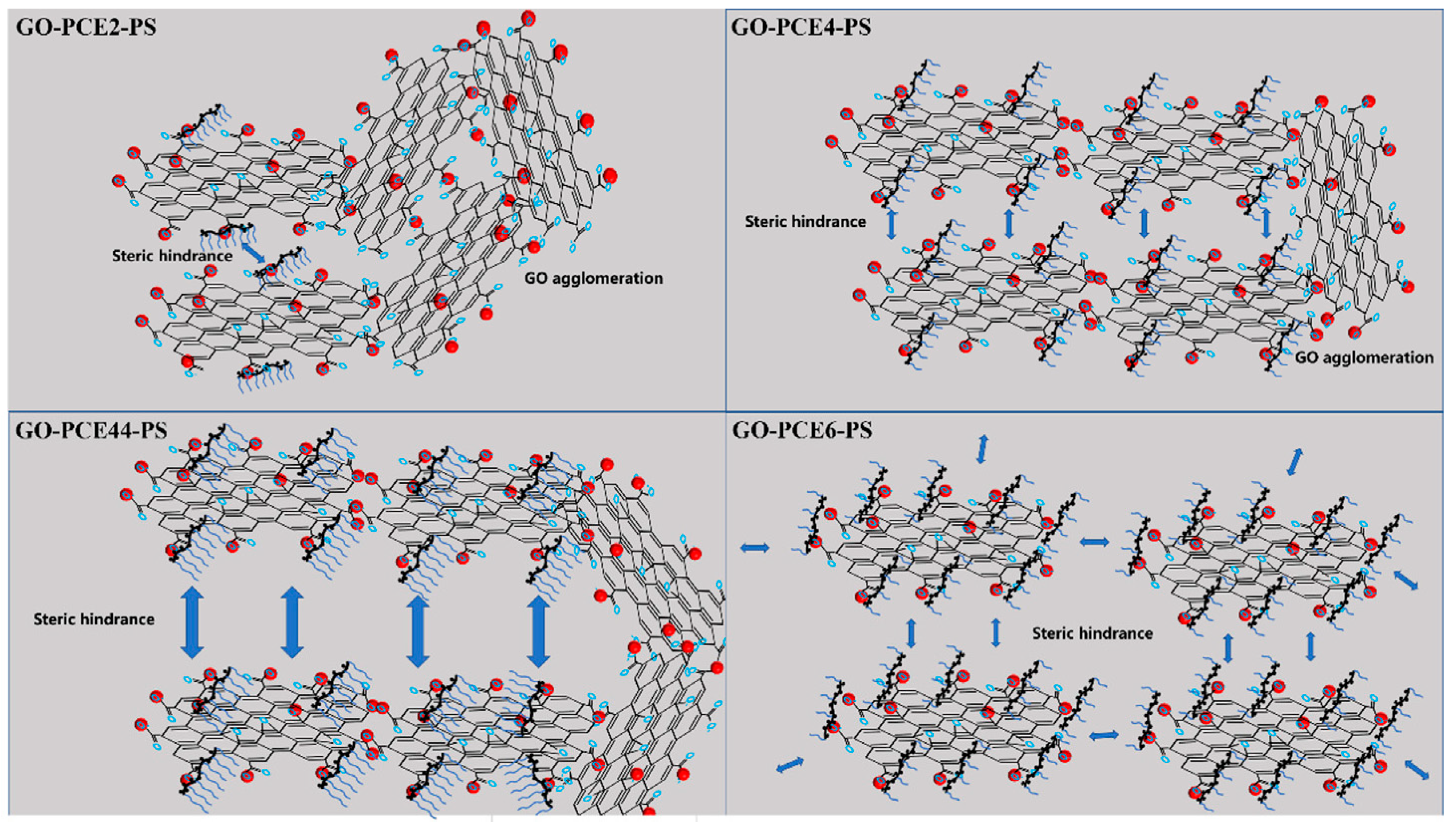
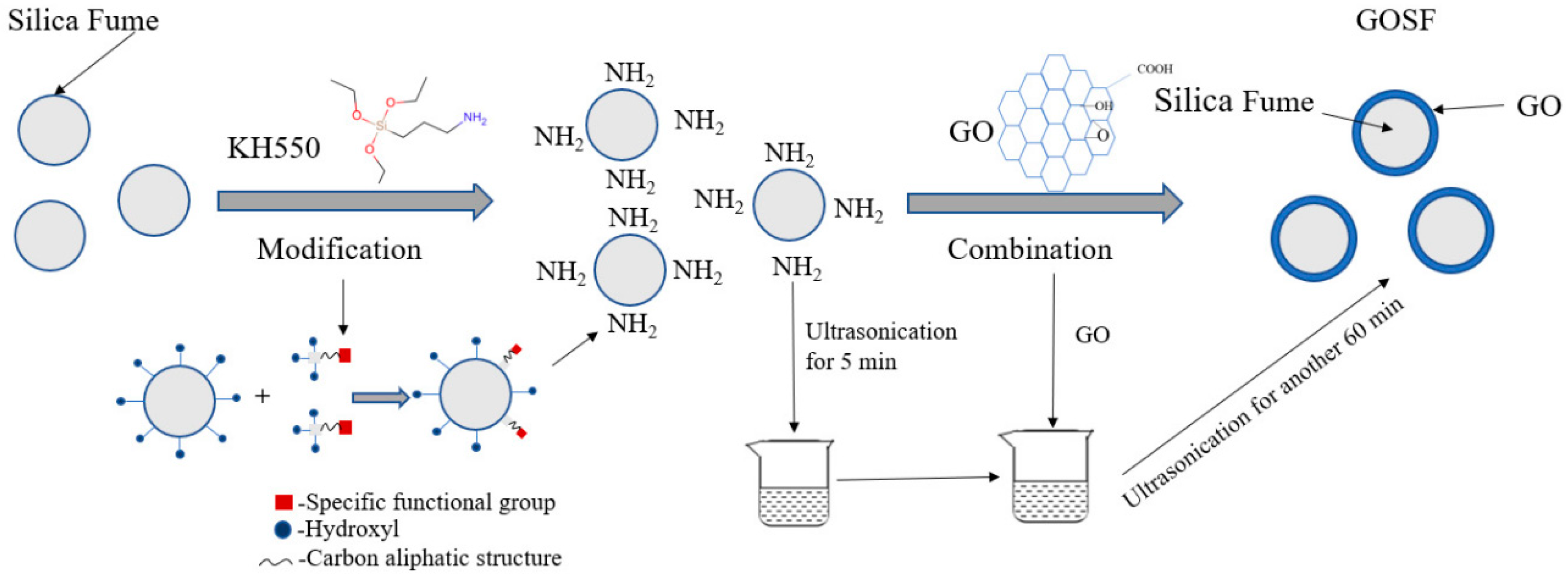
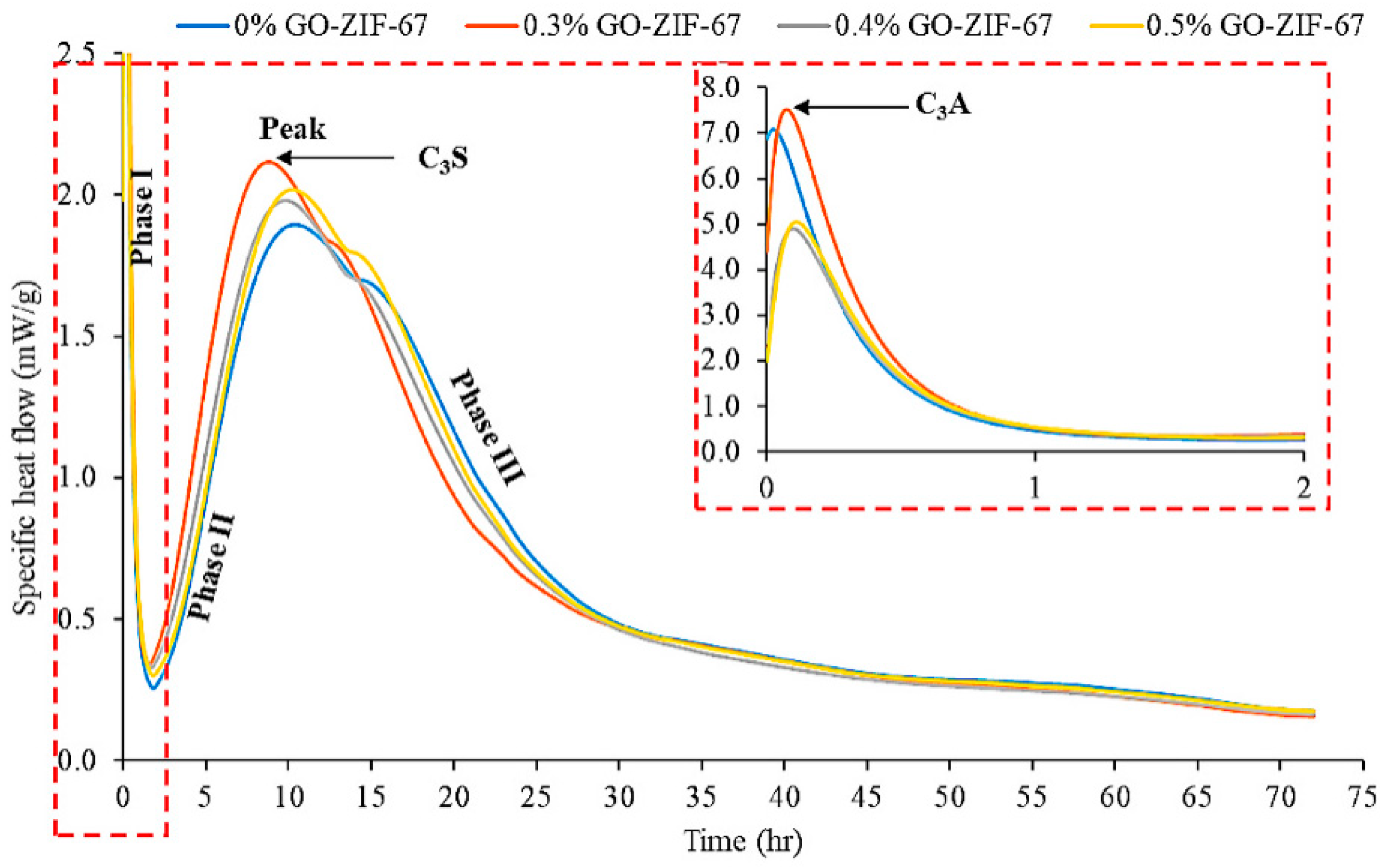
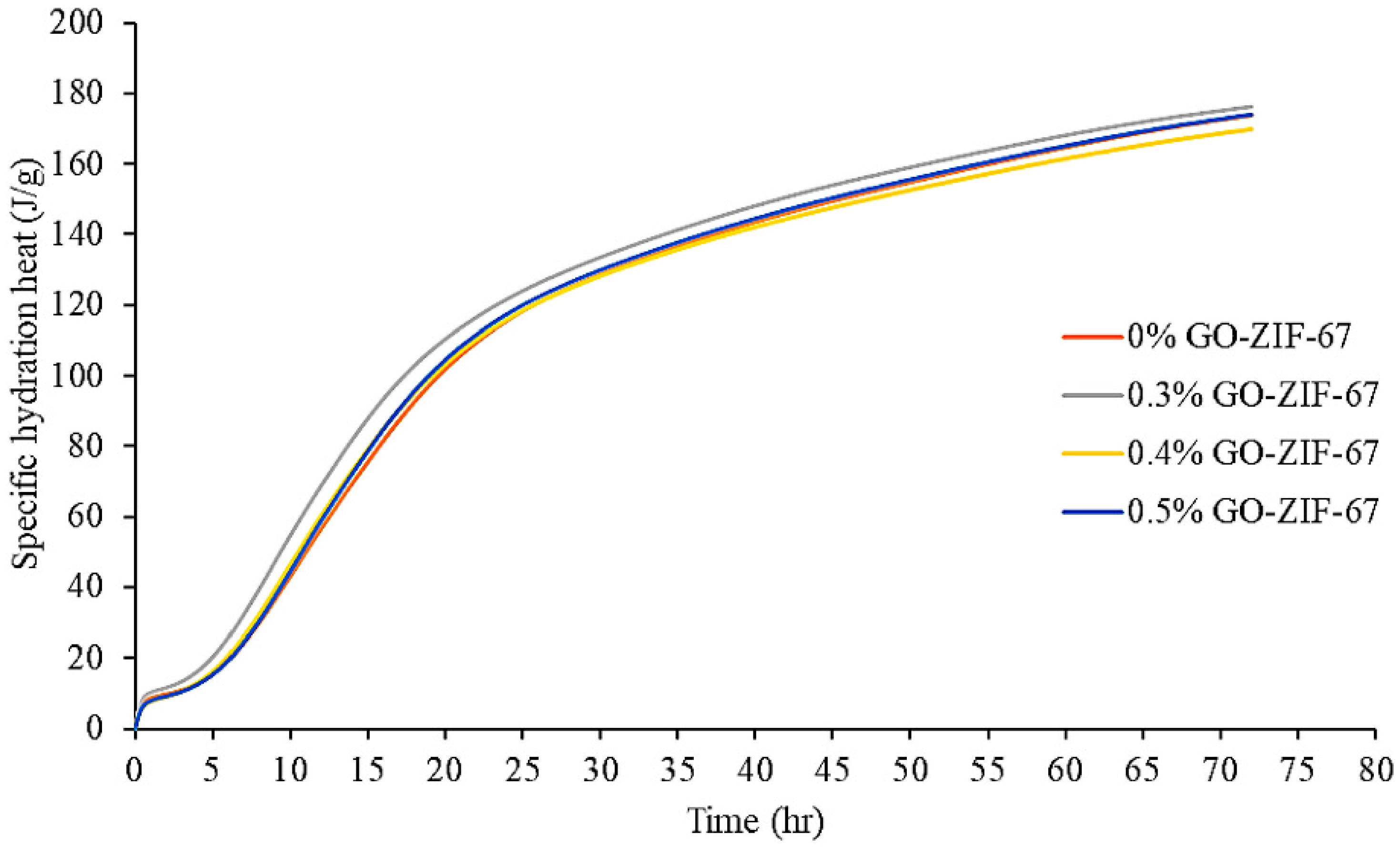
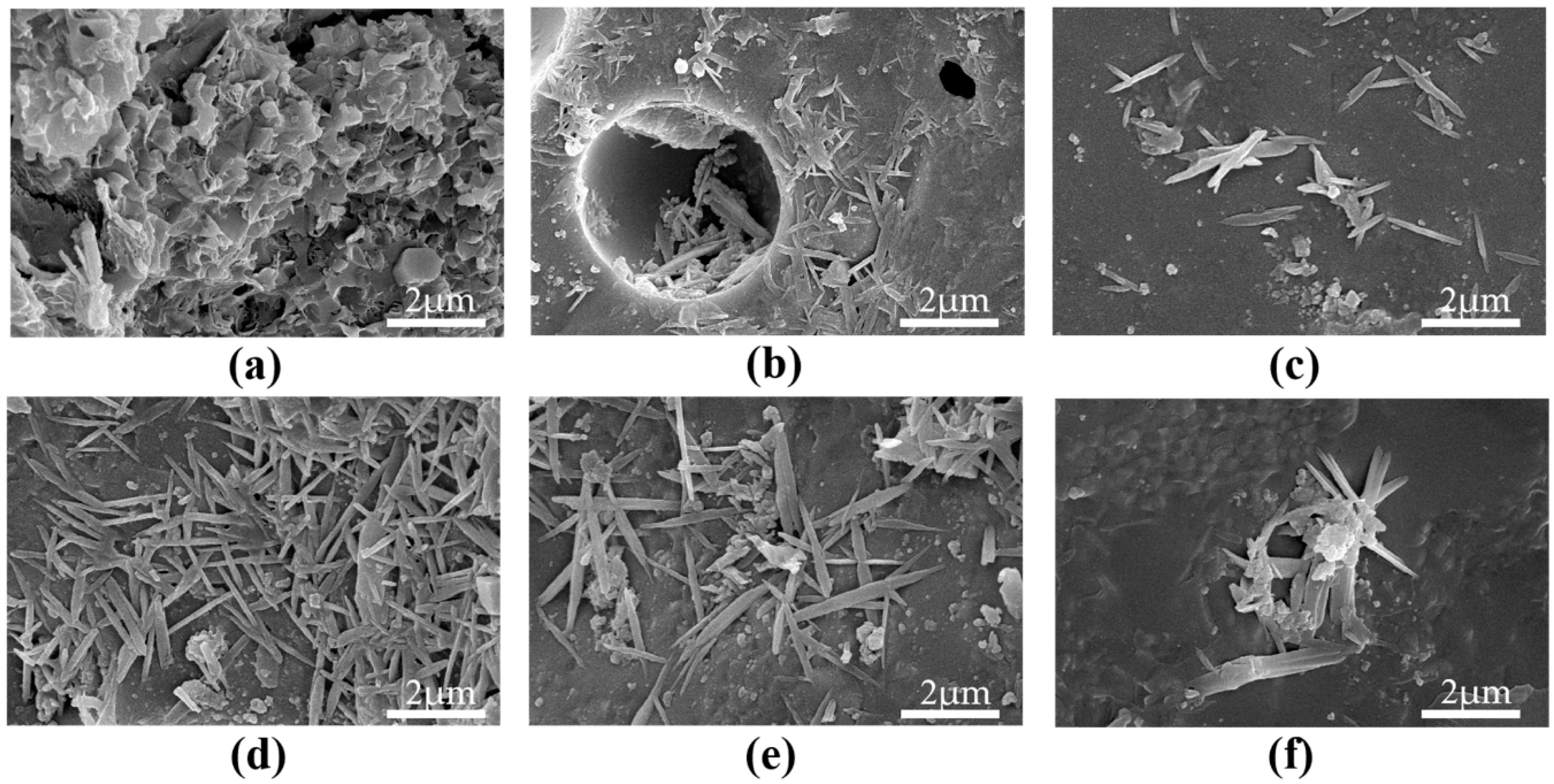
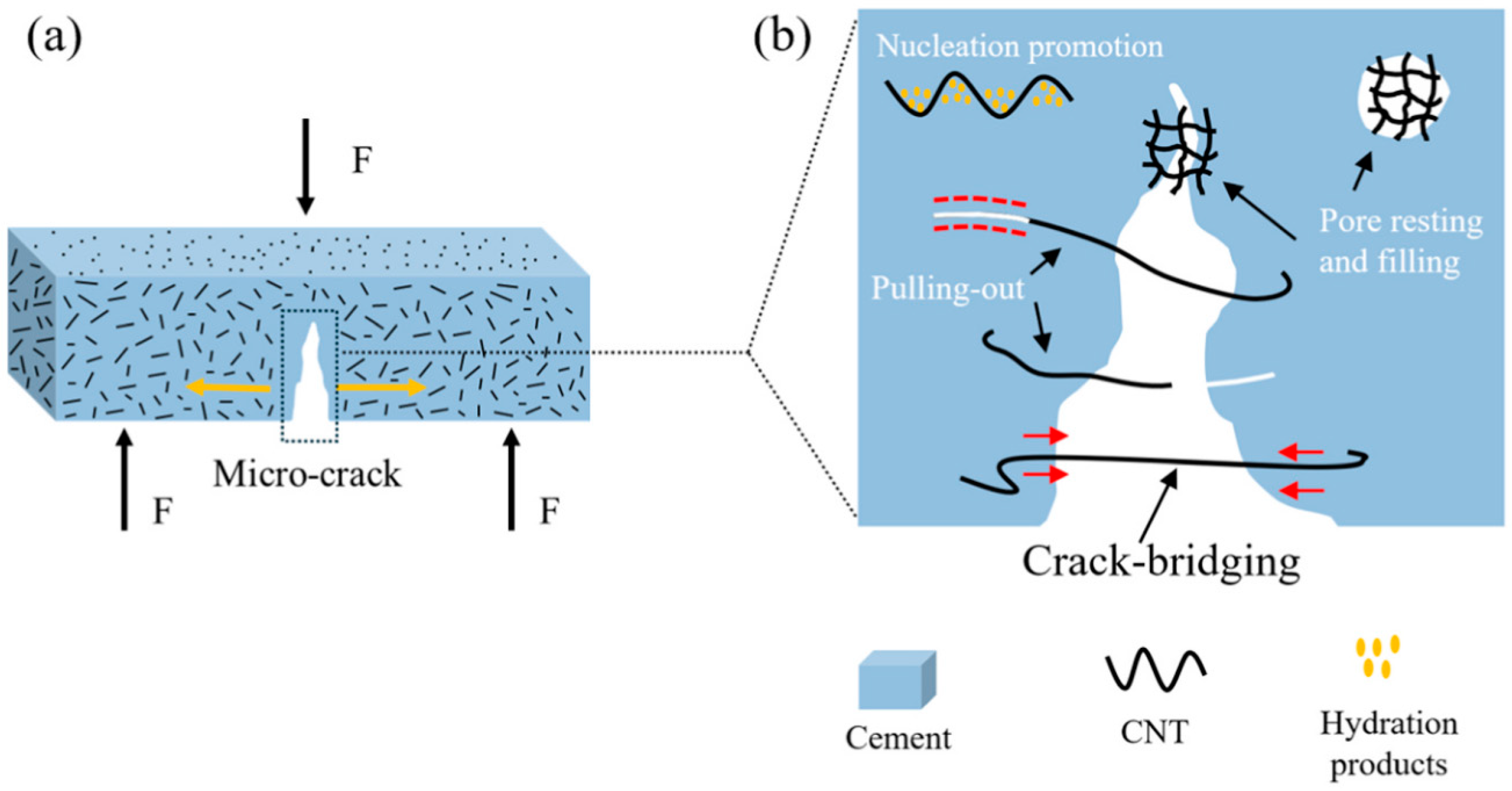
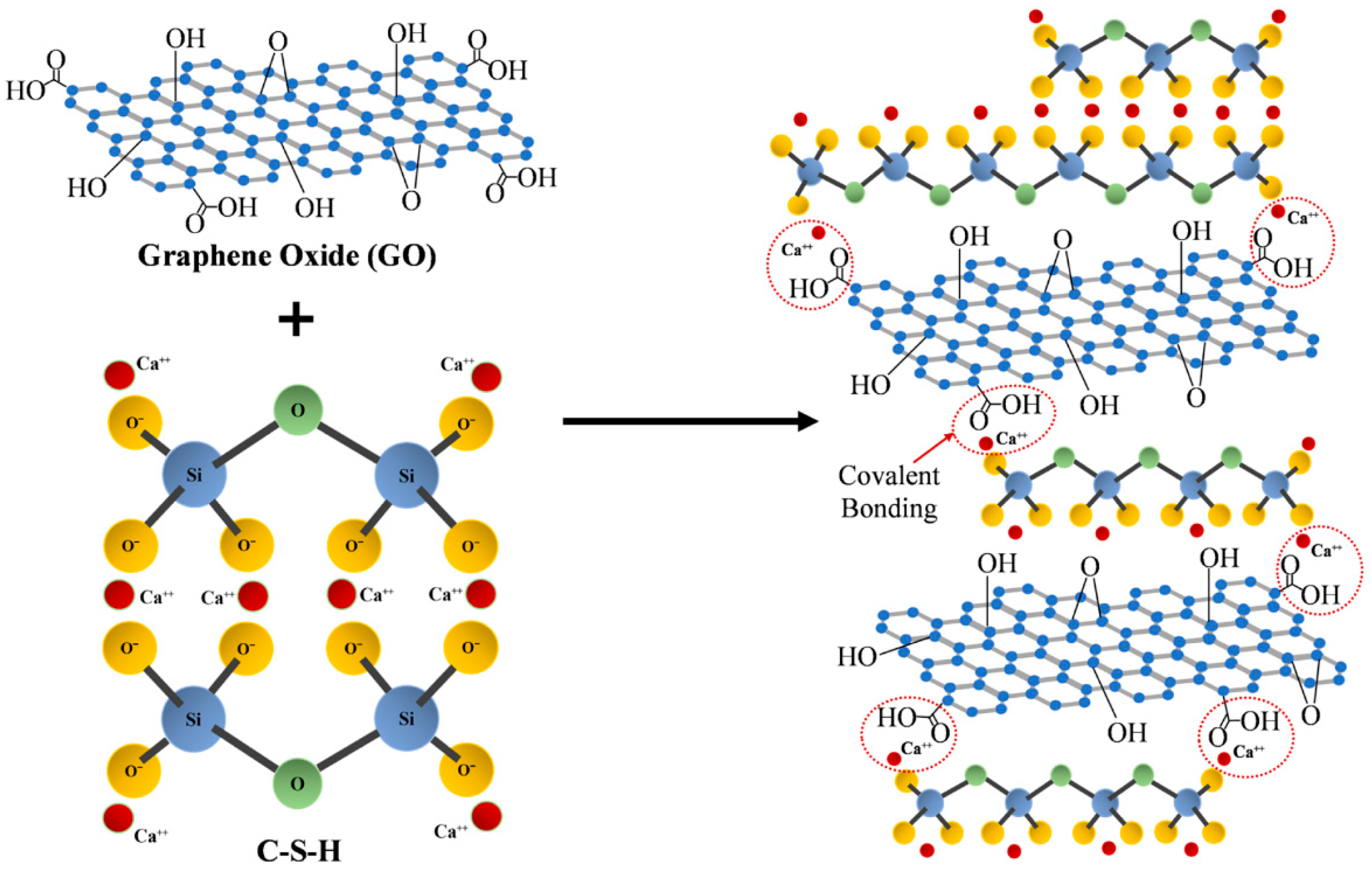
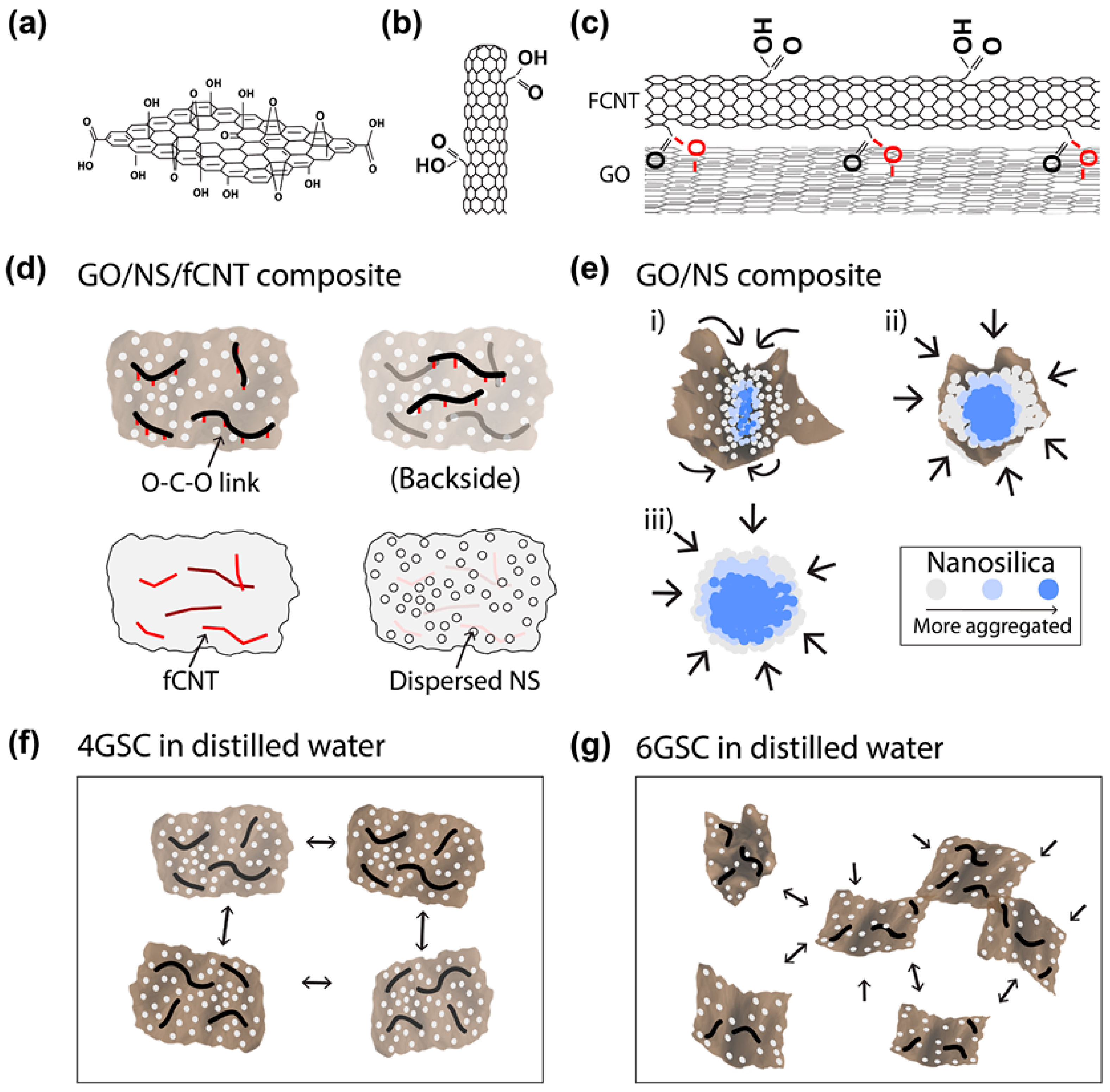

| Matrix | w/c a | GO (wt) b | Dispersion Method | Refs. | |
|---|---|---|---|---|---|
| Mechanical | Admixture | ||||
| Paste | 0.5 | 0.05 | Mechanically stirring | - | [46] |
| Concrete | 0.4 | 0.02 | Ultrasonication | FA c, PCE d | [47] |
| Concrete | 0.54 | 0.02–0.08 | Mechanically stirring | PCE | [30] |
| Mortar | 0.35 | 0.05 | - | PCE | [48] |
| Concrete | 0.35 | 0.08 | Mechanically stirring | PCE | [49] |
| Paste | 0.4 | 0.05 | Mechanically stirring | PCE | [26] |
| Mortar | 0.4 | 0.03 | - | PCE | [50] |
| Mortar | 0.5 | 0.04 | Mechanically stirring | PCE | [51] |
| Paste | 0.35 | 0.002–0.006 | Mechanically stirring | PCE, RFP e | [23] |
| Mortar | 0.5 | 0.02 | Mechanically stirring | [11] | |
| Concrete | 0.23 | 0.02–0.06 | Mechanically stirring | SP f, steel fiber, SF g | [52] |
| Paste | 0.4 | 0.05 | Mechanically stirring | SP | [37] |
| Paste | 0.6 | 0.008 | Mechanically stirring | FA, SP | [53] |
| Paste | 0.5 | 0.02–0.08 | Mechanically stirring | SP | [38] |
| Mortar | 0.45 | 0.05 | Ultrasonication | SP | [32] |
| Paste | 0.42 | 0.01–0.05 | Mechanically stirring | [54] | |
| Concrete | 0.45 | 0.025, 0.05 | Mechanically stirring | FA, SP | [55] |
| Paste | 0.17 | 0.02–0.06 | Mechanically stirring | SP | [56] |
| Matrix | w/c | GO Content (wt%) a | Method | The Change of Fluidity/Slump | Refs. |
|---|---|---|---|---|---|
| Paste | 0.4 | 0.02 | Mini-slump test | The initial and final setting times decreased by 22.2% and 15.9%, respectively. | [72] |
| Concrete | 0.35 | 0.08 | Mini-slump test | The workability decreased by 40%. | [49] |
| Paste | 0.4 | 0.04 | Mini-slump test | The initial setting times decreased by 40.9%. | [73] |
| Mortar | 0.3 | 0.1 | Mini-slump test | The workability decreased by 54%. | [74] |
| Paste | 0.5 | 0.03 | Mini-slump test | The slump flow diameter was 20% lower. | [75] |
| Paste | 0.8 | 0.03 | Slump test | The slump flow was 11.8% lower. | [76] |
| Paste | 0.8 | 0.15 | Mini-slump test | The flowability decreases by 36.7%. | [19] |
| Concrete | 0.45 | 0.05 | Slump cone test | The initial slump reduces by 16.7%. | [55] |
| Concrete | 0.5 | 0.2 | Slump testing | The slump flow was 20% lower. | [70] |
| Concrete | 0.29 | 0.08 | Slump test | The slump flow was 10.2% lower. | [71] |
| Concrete | 0.54 | 0.08 | Slump test | The slump flow was 81% lower. | [30] |
| Matrix | W/C | Compressive Strength | Flexural Strength | Tensile Strength | Refs. | |||
|---|---|---|---|---|---|---|---|---|
| GO (wt%) a | Increase (%)/d | GO (wt%) | Increase (%)/d | GO (wt%) | Increase (%)/d | |||
| Mortar | 0.5 | 0.02 | 24.5/7 | 0.02 | 18/7 | - | - | [11] |
| Mortar | 0.3 | 0.1 | 26.7/28 | 0.1 | 32.7/28 | 0.06 | 14.2/28 | [71] |
| Paste | 0.4 | 0.02 | 11.4/28 | - | - | - | - | [82] |
| Paste | 0.5 | 0.06 | 42.0/28 | - | - | [38] | ||
| Paste | 0.38 | 0.005 | 11.9/28 | - | - | 0.01 | 17.1/28 | [12] |
| Concrete | 0.18 | - | - | 0.04 | 14.7/ N.A. b | - | - | [39] |
| Concrete | 0.23 | 0.04 | 11.1/ N.A. | - | - | - | - | [52] |
| Paste | 0.4 | 0.05 | 9.7/28 | 0.05 | 19.4/28 | - | - | [26] |
| Paste | 0.35 | 0.04 | 17/28 | 0.04 | 34.6/28 | - | - | [23] |
| Mortar | 0.4 | 0.06 | 33.9/28 | 0.06 | 47.2/28 | - | - | [40] |
| Concrete | 0.54 | 0.08 | 21/28 | - | - | 0.08 | 12/28 | [30] |
| Concrete | 0.54 | 0.12 | 33/28 | 0.12 | 25/28 | 0.12 | 24/28 | [18] |
| Concrete | 0.18 | 0.06 | 7.7/28 | - | - | 0.06 | 28.39/28 | [31] |
| Paste | 0.5 | 0.03 | 25/28 | 0.03 | 20/28 | - | - | [72] |
| Concrete | 0.4 | 0.06 | 30.0/28 | - | - | - | - | [83] |
| Paste | 0.8 | 0.03 | 22.1/28 | 0.03 | 24.1/28 | - | - | [19,73] |
| Paste | 0.45 | 0.05 | 57.4/28 | 0.05 | 48.2/28 | - | - | [84] |
| Paste | 0.4 | 0.12 | 12.1/90 | 0.04 | 57.3/90 | - | - | [63] |
| Concrete | 0.4 | 0.06 | 30/28 | 0.06 | 33/28 | - | - | [76] |
| Paste | 0.4 | 0.04 | 9.3/28 | - | - | 0.04 | 14.0/28 | [85] |
| Paste | 0.45 | - | - | - | - | 0.025 | 16/28 | [79] |
| Concrete | 0.29 | 0.06 | 17.7/28 | 0.06 | 21.9/28 | - | - | [75] |
| Paste | 0.42 | 0.03 | 21.7/28 | - | - | - | - | [54] |
| Concrete | 0.45 | 0.025 | 10.4/28 | 0.05 | 3.6/28 | 0.05 | 3.1/28 | [55] |
Disclaimer/Publisher’s Note: The statements, opinions and data contained in all publications are solely those of the individual author(s) and contributor(s) and not of MDPI and/or the editor(s). MDPI and/or the editor(s) disclaim responsibility for any injury to people or property resulting from any ideas, methods, instructions or products referred to in the content. |
© 2025 by the authors. Licensee MDPI, Basel, Switzerland. This article is an open access article distributed under the terms and conditions of the Creative Commons Attribution (CC BY) license (https://creativecommons.org/licenses/by/4.0/).
Share and Cite
Hu, Z.-Y.; Wan, Y.; Duan, Y.-J.; Shi, Y.-H.; Gu, C.-P.; Ma, R.; Dong, J.-J.; Cui, D. A Review of the Impact of Graphene Oxide on Cement Composites. Nanomaterials 2025, 15, 216. https://doi.org/10.3390/nano15030216
Hu Z-Y, Wan Y, Duan Y-J, Shi Y-H, Gu C-P, Ma R, Dong J-J, Cui D. A Review of the Impact of Graphene Oxide on Cement Composites. Nanomaterials. 2025; 15(3):216. https://doi.org/10.3390/nano15030216
Chicago/Turabian StyleHu, Ze-Yuan, Yi Wan, Yan-Jun Duan, Ye-Hui Shi, Chun-Ping Gu, Rui Ma, Jian-Jun Dong, and Dong Cui. 2025. "A Review of the Impact of Graphene Oxide on Cement Composites" Nanomaterials 15, no. 3: 216. https://doi.org/10.3390/nano15030216
APA StyleHu, Z.-Y., Wan, Y., Duan, Y.-J., Shi, Y.-H., Gu, C.-P., Ma, R., Dong, J.-J., & Cui, D. (2025). A Review of the Impact of Graphene Oxide on Cement Composites. Nanomaterials, 15(3), 216. https://doi.org/10.3390/nano15030216









